NCERT Solutions | Class 8 Maths Chapter 13 | Direct and Indirect proportions

CBSE Solutions | Maths Class 8
Check the below NCERT Solutions for Class 8 Maths Chapter 13 Direct and Indirect proportions Pdf free download. NCERT Solutions Class 8 Maths were prepared based on the latest exam pattern. We have Provided Direct and Indirect proportions Class 8 Maths NCERT Solutions to help students understand the concept very well.
NCERT | Class 8 Maths
| Book: | National Council of Educational Research and Training (NCERT) |
|---|---|
| Board: | Central Board of Secondary Education (CBSE) |
| Class: | 8th |
| Subject: | Maths |
| Chapter: | 13 |
| Chapters Name: | Direct and Indirect proportions |
| Medium: | English |
Direct and Indirect proportions | Class 8 Maths | NCERT Books Solutions
You can refer to MCQ Questions for Class 8 Maths Chapter 13 Direct and Indirect proportions to revise the concepts in the syllabus effectively and improve your chances of securing high marks in your board exams.
NCERT Solutions for Class 8 Maths Chapter 13 Direct and Inverse Proportions Exercise 13.1
Ex 13.1 Class 8 Maths Question 1.
Following are the car parking charges near a railway station upto4 hours ₹ 60
8 hours ₹ 100
12 hours ₹ 140
24 hours ₹ 180
Check if the parking charges are in direct proportion to the parking time.
Solution:
∴ The parking charges are not in direct proportion to the parking time.
Ex 13.1 Class 8 Maths Question 2.
A mixture of paint is prepared by mixing 1 part of red pigments with 8 parts of base. In the following table, find the parts of base that need to be added.
Solution:
It is given that parts of red pigment, say x and parts of base, say y are in direct proportion. Therefore, the ratio of the corresponding values of x and y remain constant.We have, \(\frac { 1 }{ 8 } =\frac { 1 }{ 8 } \).
So, x and y are in direct variation with the constant of variation equal to \(\frac { 1 }{ 8 } \). This means that x is \(\frac { 1 }{ 8 } \) of y and y is eight times of x. Thus, the required entries are \(\frac { 4 }{ 32 } ,\frac { 7 }{ 56 } ,\frac { 12 }{ 96 } ,\frac { 20 }{ 160 } \).
Thus, table becomes

Ex 13.1 Class 8 Maths Question 3.
In Question 2 above, if 1 part of a red pigment requires 75 ml. of base, how much red pigment should we mix with 1800 ml of base?Solution:
Suppose x parts of red pigment should be mixed with 1800 mL of base. Then the above information can be put in the tabular form as follows:
Ex 13.1 Class 8 Maths Question 4.
A machine in a soft drink factory fills 840 bottles in six hours. How many bottles will it fill in five hours?Solution:
Suppose x bottles be filled up in five hours. Then the information can be put in the following tabular form :
We observe that the lesser the time consumed, the lesser the number of botdes filled up. So, it is a case of direct variation.

Hence, 700 botdes will be filled up in 5 hours.
Ex 13.1 Class 8 Maths Question 5.
A photograph of a bacteria enlarged 50,000 times attains a length of 5 Cm as shown in the diagram. What is the actual length of the bacteria? If the photograph is enlarged 20,000 times only, what would be its enlarged length?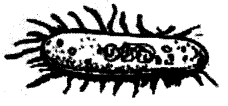
Solution:

Suppose x be the enlarged length of the bacteria when its photograph is enlarged 20000 times. Then the information can be put in the following tabular form :

Hence, its enlarged length is 2 cm.
Ex 13.1 Class 8 Maths Question 6.
In a model of a ship, the mast is 9 cm high, while the mast of the actual ship is 12 m high. If the length of the ship is 28 m, how long is the model ship?Solution:
Let x metres be the length of the model ship of actual length 28 m. Then the information can be put in the following tabular form :
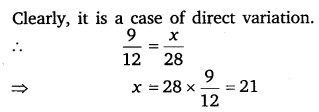
Hence, the length of the model ship is 21 cm.
Ex 13.1 Class 8 Maths Question 7.
Suppose 2 kg of sugar contains 9 x 106 crystals. How many sugar crystals are there in(i) 5 kg of sugar?
(ii) 1.2 kg of sugar?
Solution:
Let x and y crystals are in 5 kg of sugar and 1.2 kg of sugar. Then, the given information can be exhibited in the following tabular form :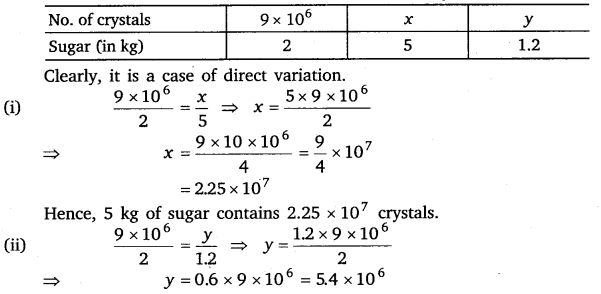
Hence, 1.2 kg of sugar contains 5.4 x 106 crystals.
Ex 13.1 Class 8 Maths Question 8.
Rashmi has a road map with a scale of 1 cm representing 18 km. She drives on a road for 72 km. What would be her distance covered in the map?Solution:
Let x cm be the distance covered in the map for the drives of 72 km on a road. Then, the given information can be exhibited in the following tabular form.
Ex 13.1 Class 8 Maths Question 9.
A 5 m 60 cm high vertical pole casts a shadow 3 m 20 cm long. Find at the same time (i) the length of the shadow cast by another pole 10 m 50 cm high (ii) the height of a pole which casts a shadow 5 m long.Solution:
Let x m be the length of the pole whose shadow is of length 10 m 50 cm.Let y m be the length of the pole whose shadow is 5 m long.
Then, the given information can be exhibited in the following tabular form :
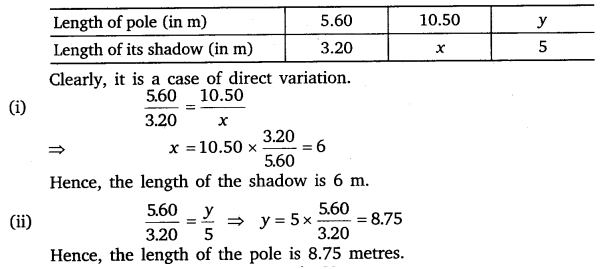
Ex 13.1 Class 8 Maths Question 10.
A loaded truck travels 14 km in 25 minutes. If the speed remains the same, how far can it travel in 5 hours?Solution:
Let the truck travels x km in 5 hours. Then, the given information can be exhibited in the following tabular form :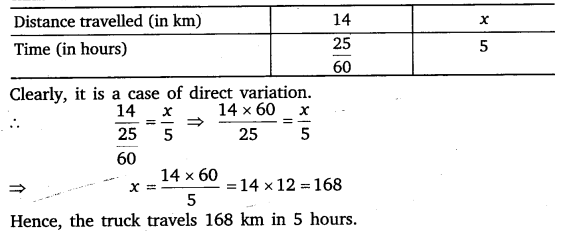
NCERT Solutions for Class 8 Maths Chapter 13 Direct and Inverse Proportions Exercise 13.2
Ex 13.2 Class 8 Maths Question 1.
Which of the following are in inverse proportion?(i) The number of workers on a joh and the time to complete the job.
(ii) The time taken for a journey and the distance travelled in a uniform speed.
(iii) Area of cultivated land and the crop harvested.
(iv) The time taken for a fixed journey and the speed of the vehicle.
(v) The population of a country and the area of land per person.
Solution:
(i) We know that more is the number of workers to do a job, less is the time taken to finish the job.So, it is a case of inverse proportion.
(ii) Clearly, more is the time taken, more is the distance travelled in a uniform speed.
So, it is a case of direct proportion.
(iii) Clearly, more is the area cultivated land, more is the crop harvested. So, it is a case of direct proportion.
(iv) We know that more is the speed of the vehicle, less is the time to cover a fixed distance.
So, it is a case of inverse proportion.
(v) Clearly, more is the population, less is the area of land per person in a country.
So, it is a case of inverse proportion.
Ex 13.2 Class 8 Maths Question 2.
In a Television game show, the prize money of ₹ 1,00,000 is to be divided equally amongst the winners. Complete the following table and find whether the prize money given to an individual winner is directly or inversely proportional to the number of winners?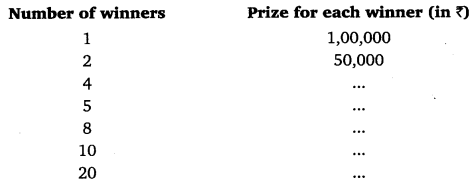
Solution:
Clearly, more the number of winners, less is the prize for each winner. So, it∴ 4 x x = 1 x 100000
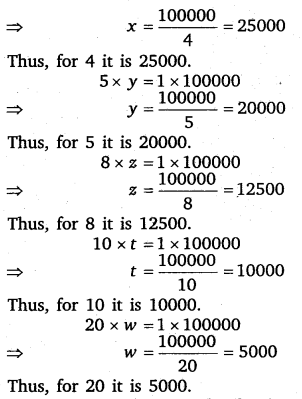
Ex 13.2 Class 8 Maths Question 3.
Rehman is making a wheel using spokes. He wants to fix equal spokes in such a way that the angles between any pair of consective spokes are equal. Help him by completing the following table.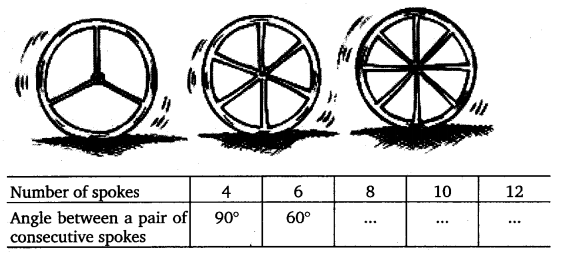
(i) Are the number of spokes and the angles formed between the pairs of consecutive spokes in inverse proportion?
(ii) Calculate the angle between a pair of consecutive spokes on a wheel with 15 spokes.
(iii) How many spokes would be needed, if the angle between a pair of consecutive spokes is 40°?
Solution:
Clearly, more is the number of spokes, less is the measure of angle between a pair of consecutive spokes.Also, we observe here
4 x 90° = 6 x 60° (= 360°)
So, it is a case of inverse proportion.
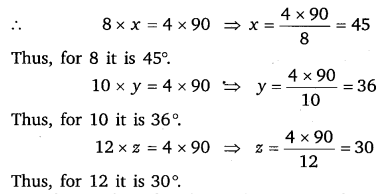
(i) Yes, the number of spokes and the angles formed between the pairs of consecutive spokes are in inverse proportion.
(ii) Let x° be the angle between a pair of consecutive spokes on a wheel with 15 spokes.
∴ 15 x x = 4 x 90 ⇒ x= \(\frac { 4\times 90 }{ 15 } \) = 24
Thus, the required angle is 24°.
(iii) Let x spokes are needed on a wheel if the angle between a pair of consecutive spokes is 40°.
∴ x x 40 = 4 x 90 ⇒ x= \(\frac { 4\times 90 }{ 40 } \) = 9
Thus, the required number of spokes is 9.
Ex 13.2 Class 8 Maths Question 4.
If a box of sweets is divided among 24 children, they will get 5 sweets each. How many would each get, if the number of the children is reduced by 4?Solution:
Since the number of the children were reduced by 4. Therefore, their number becomes 24 – 4 = 20.Let each child get x sweets when their number is 20.
Thus, we have the following table :

Since less children will get more sweets. So, it is a case of inverse proportion.
∴ 24 x 5 = 20 x x ⇒ x= \(\frac { 24\times 5 }{ 20 } \) = 6
Hence, each child will get 6 sweets.
Ex 13.2 Class 8 Maths Question 5.
A farmer has enough food to feed 20 animals in his cattle for 6 days. How long would the food last if there were 10 more animals in his cattle?Solution:
Let the food will now last for x days. Then,
Clearly, more is the number of animals, less will be the number of days for food to last. .
So, it is a case of inverse proportion.
∴ 24 x 6 = 30 x x ⇒ x= \(\frac { 20\times 6 }{ 30 } \) = 4
Hence, the food will now last for 4 days.
Ex 13.2 Class 8 Maths Question 6.
A contractor estimates that 3 persons could rewire Jasminder’s house in 4 days. If, he uses 4 persons instead of three, how long should they take to complete the job?Solution:
Let the rewiring be completed by 4 persons in x days.
Clearly, more is the number of persons, less is the number of days required.
So, it is a case of inverse proportion.
∴ 4 x 3 = x x 4 ⇒ x= \(\frac { 4\times 3 }{ 3 } \) = 3
Hence, the job will be completed in 3 days.
Ex 13.2 Class 8 Maths Question 7.
A batch of bottles were packed in 25 boxes with 12 bottles in each box. If the same batch is packed using 20 bottles in each box, how many boxes would be filled?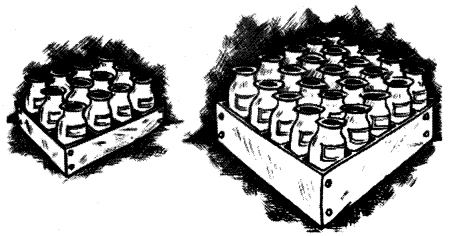 Solution:
Solution:Let JC boxes be needed when 20 bottles are packed in each box. Then,

Clearly, more is the number of bottles, less will be the number of boxes needed for packing.
So, it is a case of inverse proportion.
∴ 25 x 12 = x x 20 ⇒ x= \(\frac { 25\times 12 }{ 20 } \) = 15
Hence, the boxes needed for packing is 15.
Ex 13.2 Class 8 Maths Question 8.
A factory requires 42 machines to produce a given number of articles in 63 days. HoW many machines would be required to produce the same number of articles in 54 days?Solution:
Let x machines are required to produce a fixed number of articles in 54 days. Then,
Clearly, less is the number of days to produce a fixed number of articles, more machines are required.
So, it is a case of inverse proportion.
∴ 42 x 63 = x x 54 ⇒ x= \(\frac { 42\times 63 }{ 54 } \) = 49
Hence, the number of machines needed is 49.
Ex 13.2 Class 8 Maths Question 9.
A car takes 2 hours to reach a destination by travelling at the speed of 60 km/h. How long will it take when the car travels at the speed of 80 km/h?Solution:
Let the car takes x hours to reach a destination by travelling at the speed of 80 km/h. Then,
Clearly, more the speed, less will be the time taken. So, it is a case of inverse proportion.
∴ 60 x 2 = 80 x x ⇒ x= \(\frac { 60\times 2 }{ 80 } \) = \(\frac { 3 }{ 2 } \)
Hence, the time taken will be 1\(\frac { 1 }{ 2 } \) hours.
Ex 13.2 Class 8 Maths Question 10.
Two persons could fit new windows in a house in 3 days.(i) One of the persons fell ill before the work started. How long would the job take now?
(ii) How many persons would be needed to fit the windows in one day?
Solution:
(i) Let x days be taken to fix the windows. Then
Clearly, less the number of persons, more will be the number of days to fix the windows.
So, it is a case of inverse proportion.
∴ 2 x 3 = 1 x x ⇒ x = 6
Hence, one person will finish the given work in 6 days.
(ii) Let x persons will fix the windows in 1 day. Then,

Clearly, less the number of days, more will be the number of persons to fix the windows.
So, it is a case of inverse proportion
∴ 2 x 3 = x x 1
⇒ x = 6
Hence, 6 persons will finish the given work in 1 day.
Ex 13.2 Class 8 Maths Question 11.
A school has 8 periods a day each of 45 minutes duration. How long would each period he, if the school has 9 periods a day, assuming the number of school hours to be the same?Solution:
Let x minutes be the duration of period when the school has 9 periods a day. Then
Clearly, more the periods, less will be the duration of the period.
So, it is a case of inverse proportion.
∴ 8 x 45 = 9 x x ⇒ x = \(\frac { 8\times 45 }{ 9 } \) = 40
Hence, the duration of period is 40 minutes.
NCERT Class 8 Maths
Class 8 Maths Chapters | Maths Class 8 Chapter 13
NCERT Solutions for Class 8 Maths
NCERT Solutions of Maths Class 8 Chapter-wise
Chapter-wise NCERT Solutions for Class 8 Maths
-
NCERT Solutions For Class 8 Maths Chapter 1 Rational Numbers
NCERT Solutions For Class 8 Maths Chapter 2 Linear Equations in One Variable
NCERT Solutions For Class 8 Maths Chapter 3 Understanding Quadrilaterals
NCERT Solutions For Class 8 Maths Chapter 4 Practical Geometry
NCERT Solutions For Class 8 Maths Chapter 5 Data Handling
NCERT Solutions For Class 8 Maths Chapter 6 Squares and Square Roots
NCERT Solutions For Class 8 Maths Chapter 7 Cubes and Cube Roots
NCERT Solutions For Class 8 Maths Chapter 8 Comparing Quantities
NCERT Solutions For Class 8 Maths Chapter 9 Algebraic Expressions and Identities
NCERT Solutions For Class 8 Maths Chapter 10 Visualising Solid Shapes
NCERT Solutions For Class 8 Maths Chapter 11 Mensuration
NCERT Solutions For Class 8 Maths Chapter 12 Exponents and Powers
NCERT Solutions For Class 8 Maths Chapter 13 Direct and Indirect proportions
NCERT Solutions For Class 8 Maths Chapter 14 Factorisation
NCERT Solutions For Class 8 Maths Chapter 15 Introduction to Graphs
NCERT Solutions For Class 8 Maths Chapter 16 Playing with Numbers
NCERT Solutions for Class 6 to 12
-
NCERT Solutions for Class 6 All Subjects
NCERT Solutions for Class 7 All Subjects
NCERT Solutions for Class 8 All Subjects
NCERT Solutions for Class 9 All Subjects
NCERT Solutions for Class 10 All Subjects
NCERT Solutions for Class 11 All Subjects
NCERT Solutions for Class 12 All Subjects

Post a Comment
इस पेज / वेबसाइट की त्रुटियों / गलतियों को यहाँ दर्ज कीजिये
(Errors/mistakes on this page/website enter here)